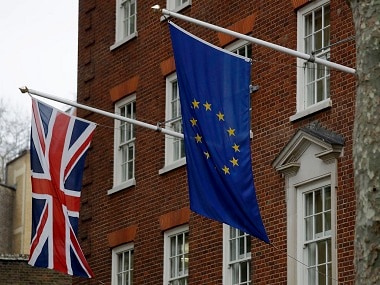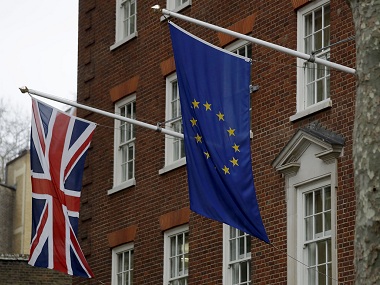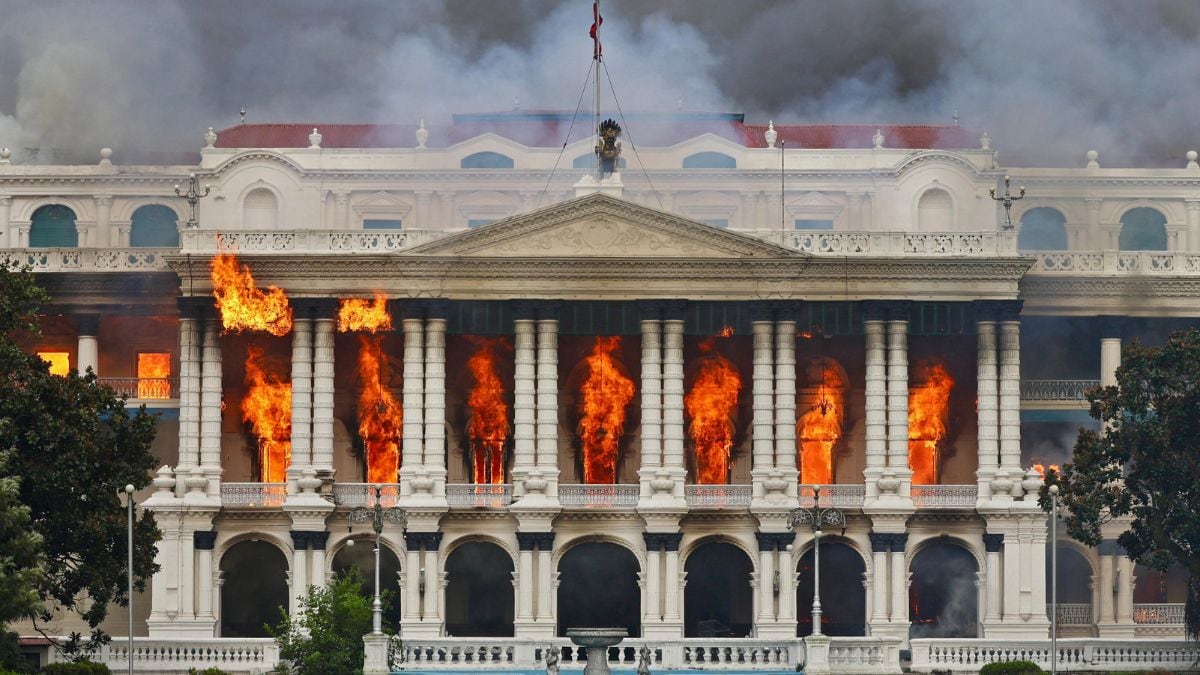The UK Parliament has been suspended till 14 October as the country prepares to leave the European Union with a “no-deal” Brexit on 31 October. European Parliament president David Sassoli said British prime minister Boris Johnson’s government has made no new proposals that would unblock Brexit talks and that talking about removing the so-called backstop from the divorce agreement is a waste of time. Here is a timeline of key events since Britain voted to leave the European Union: 23 June, 2016: UK referendum has 52 percent of voters in favour of withdrawing from the 28-nation EU. [caption id=“attachment_5029711” align=“alignleft” width=“380”]  Representational image. AP[/caption] 24 June, 2016: Conservative prime minister David Cameron, who called the referendum but led the campaign to preserve Britain’s four-decade membership in the bloc, resigns. 13 July, 2016: Theresa May, the interior minister, becomes prime minister. 13 August, 2016: Chancellor Philip Hammond guarantees EU funding beyond the date the UK leaves the EU. 8 September, 2016: May holds her first formal bilateral meeting with European Council president Donald Tusk to discuss the UK’s withdrawal from the EU. 3 January, 2017: Sir Ivan Rogers, the UK’s Permanent Representative to the EU, resigns. He is succeeded by Sir Tim Barrow. 17 January, 2017: May sets out Brexit strategy, saying Britain will leave Europe’s single market and control EU immigration. 7 February, 2017: UK ministers hold the first meeting of a new forum dedicated to discussing the implications of Brexit for the Overseas Territories. 8 February, 2017: The European Union (Notification of Withdrawal) Bill passes its Third Reading in the House of Commons, by 494 votes to 122. The Bill now moves to the House of Lords. 13 March, 2017: Parliament passes the European Union (Notification of Withdrawal) Bill. 16 March, 2017: European Union (Notification of Withdrawal) Act receives Royal Assent. 29 March, 2017: The British government formally triggers Article 50, with a letter to the EU Council formally announcing Britain’s intention to leave, setting in motion a plan for Britain to leave the EU on 29 March, 2019. 31 March, 2017: The president of the European Council publishes draft negotiation guidelines for the EU 27 (the EU members, excluding the UK). 18 April, 2017: May calls for General Election on 8 June. 8 June, 2017: Snap elections called by May are conducted. Conservatives lose their parliamentary majority and are forced to strike a deal for support from Northern Ireland’s Democratic Unionist Party (DUP). 17 June, 2017: The government confirms that Parliament will sit for two years instead of the usual one, to give MPs enough time to fully consider the laws required to make Britain ready for Brexit. 19 June, 2017: The first round of EU exit negotiations begins. The UK and the European Commission, representing the EU, agree the Terms of reference for the Article 50 negotiations between the UK and the EU. 13 July, 2017: The Government introduces the European Union (Withdrawal) Bill. 22 September, 2017: The prime minister delivers a key Brexit speech in Florence, setting out the UK’s position on how to move the Brexit talks forward and offering a transition period after the UK formally leaves the EU in March 2019. 20 December, 2017: May writes an open letter to UK nationals living in Europe. 18 January, 2018: First Reading of the European Union (Withdrawal) Bill in the House of Lords. 26 January, 2018: The Chancellor, Brexit Secretary and Business Secretary write an open letter to businesses, setting out the UK’s ambitions for an ‘implementation period’ (transition period) following Brexit. 21 March, 2018: The foreign secretary announces the creation of 250 new diplomatic roles over the next two years, with ten new embassies/high commissions to be opened. 23 March, 2018: The European Council (in EU 27 format) adopt guidelines on the framework for post-Brexit relations with the UK. 29 March, 2018: To mark one year to go until Brexit, May visits each nation of the UK, outlining her determination to deliver a Brexit deal that works for every community and protects the integrity of the UK. 26 June, 2018: The European Union (Withdrawal) Bill receives Royal Assent and becomes an Act of Parliament: the European Union (Withdrawal) Act. 29 October, 2018: In the last Budget before the UK leaves the EU, Chancellor Philip Hammond announces £500 million for no-deal Brexit preparations. 13 November, 2018: British and EU negotiators reach a draft divorce agreement. 14 November, 2018: The UK and the EU negotiating teams reach an agreement in principle on the Withdrawal Agreement. This establishes the terms of the UK’s departure on 29 March 2019. Following a Cabinet meeting, the prime minister makes a statement to announce the publication of the Withdrawal Agreement and the Outline Political Declaration. 22 November, 2018: May delivers a short statement outside Downing Street, saying the Brexit deal is now “within our grasp”. 25 November, 2018: EU leaders approve a withdrawal deal reached with May after months of difficult negotiations. “This is the only deal possible,” European Commission president Jean-Claude Juncker insists. 4 December, 2018: MPs begin the first of five days of Brexit debates, leading up to the ‘Meaningful Vote’ on 11 December. 5 December, 2018: Following a Motion passed in the House of Commons, the government publishes the Attorney General’s legal advice to Cabinet on the Protocol on Ireland/Northern Ireland. This is the full, final advice that the Attorney General provided to Cabinet on 14 November on the legal effect of the Withdrawal Agreement. On Day 2 of House of Commons debates on the Withdrawal Agreement and the future of the UK-EU relationship, May suffers three Brexit defeats in the Commons and the government is also found to be in contempt of Parliament. 6 December, 2018: The prime minister announces the formation of five new business councils to advise on how to create the best business conditions in the UK post-Brexit. 11 December, 2018: May wins a vote of confidence in her leadership of the Conservative Party. 13 December, 2018: The European Council (meeting as EU 27) adopts conclusions on Brexit, including further assurances on the Northern Ireland backstop. 3 January, 2019: The government publishes updated Brexit guidance for UK nationals living in the EU, in the absence of a withdrawal agreement. 9 January, 2019: As five days of Brexit debates begin – leading to a ‘Meaningful Vote’ on 15 January – an amendment to the business motion is passed, giving the prime minister only three days to present a ‘Plan B’ Brexit plan if she loses meaningful vote. The deadline was originally 21 days. 15 January, 2019: British lawmakers overwhelmingly reject the Brexit deal in a 432-202 vote, the biggest government defeat in British parliamentary history. 16 January, 2019: The British government narrowly survives a vote of no-confidence called by the main Opposition Labour Party. New talks are launched with the EU, which refuses to reopen the deal. 21 January, 2019: May gives a statement to the House of Commons, presenting the government’s ‘Plan B’ and outlining the six key issues that have been at the centre of cross-party talks. 12 March, 2019: The day’s final vote sees MPs voting on the government’s amended no-deal Brexit motion: “That this House rejects the United Kingdom leaving the European Union without a Withdrawal Agreement and a Framework for the Future Relationship”. The motion is passed by 321 votes to 278. 27 March, 2019: May promises to resign if her Brexit deal is adopted. 29 March, 2019: May’s leadership in peril as the Parliament rejects the Brexit deal for the third time. 5 April, 2019: May writes to Donald Tusk, asking for a further extension to Article 50 until 30 June, 2019. The letter also states the government is making preparations should the UK have to take part in the forthcoming European Parliament elections. 6 April, 2019: The prime minister gives a speech on the Brexit negotiations. She announces a further visit to Brussels to seek another short extension to Article 50. 10 April, 2019: In the European Council meeting, May asks for an extension of Article 50 until the end of June. 11 April, 2019: Britain and the EU agree for a second time to extend the withdrawal deadline, originally scheduled for 29 March, to keep Brexit from happening without a deal in place. The new deadline is 31 October. 17 May, 2019: The Leader of the Opposition calls off the cross-party Brexit negotiations after six weeks of talks. 21 May, 2019: The prime minister delivers a speech on her new Brexit deal. This ‘New Brexit Deal’ includes a ten-point offer to MPs. These are:
- The Government will seek to conclude Alternative Arrangements to replace the Ireland/Northern Ireland backstop by December 2020, so that it never needs to be used.
- A commitment that, should the backstop come into force, the Government will ensure that Great Britain will stay aligned with Northern Ireland.
- The negotiating objectives and final treaties for our future relationship with the EU will have to be approved by MPs.
- A new Workers’ Rights Bill that guarantees workers’ rights will be no less favourable than in the EU.
- There will be no change in the level of environmental protection when we leave the EU.
- The UK will seek as close to frictionless trade in goods with the EU as possible while outside the Single Market and ending free movement.
- We will keep up to date with EU rules for goods and agri-food products that are relevant to checks at the border, protecting thousands of jobs that depend on just-in-time supply chains.
- The Government will bring forward a customs compromise for MPs to decide on to break the deadlock.
- There will be a vote for MPs on whether the deal should be subject to a referendum.
- There will be a legal duty to secure changes to the political declaration to reflect this new deal.
23 May, 2019: The UK votes in the European Parliament elections. 24 May, 2019: May announces that she will step down as Conservative leader on 7 June, making way for the election of a new prime minister. 26 May, 2019: The results of the European Parliament elections come in. The Brexit Party wins the most votes in the UK, securing 29 seats with 31.6 percent of the vote. 7 June, 2019: May steps down as Conservative Party leader over the stalled Brexit agreement, clearing the way for Boris Johnson to take over as Tory leader and Britain’s prime minister. 23 July, 2019: Boris Johnson wins the Conservative Party leadership race, securing 92,153 votes to Jeremy Hunt’s 46,656. 24 July, 2019: Johnson takes office and almost immediately makes clear the UK will leave the EU on 31 October, with or without a deal. 28 August, 2019: Johnson says he will temporarily shut down Parliament by scheduling the Queen’s Speech for 14 October. The speech normally is a formality that outlines the legislative agenda but since Parliament is ordinarily suspended beforehand, the move means the opposition will have less time to thwart a no-deal Brexit. 4 September, 2019: MPs back a bill blocking a 31 October no-deal Brexit. Their victory means that Johnson will have to ask for a Brexit extension beyond the 31 October Brexit deadline if he can’t secure a deal with the EU. 11 September, 2019: Scotland’s appeal court rules Johnson’s action “unlawful”. The government says it will appeal the ruling.


)

)
)
)
)
)
)
)
)



